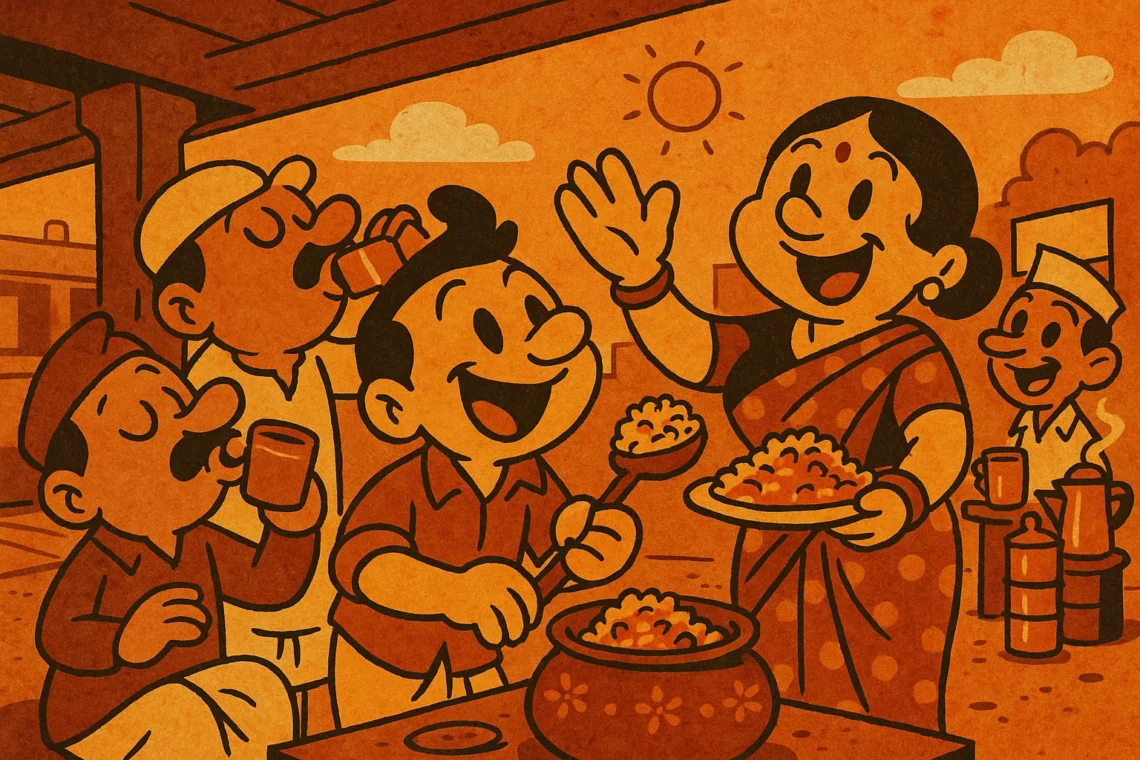There’s something about the smell of freshly made biryani wafting through the air as you wait for your train at a railway station, or as you sit hunched under the shade of a flyover, that feels both ephemeral and timeless. It’s the kind of thing that defines a city — a vibrant, chaotic, yet surprisingly comforting moment that only street food can deliver. And what better representation of this urban wonder than biryani, that glorious, spiced symphony of flavors served in humble styrofoam boxes across every street corner of India?
The Context: Under the Flyover, Around the Corner
In cities like Mumbai, where I grew up, the backdrop of life is as much about noise and movement as it is about food. And street food is the pulse of it all. I now live in Austin, Texas, a place that has its own great food scene — but there’s something utterly unique about eating on the streets in India. The locations are often unexpected, the settings are anything but glamorous, and yet, that’s where the magic happens. Under a flyover, on the crowded platform of a local train station, or at a bustling corner near a university mess hall, food becomes an experience, not just a meal.
The experience of eating biryani under a flyover is as much about the surrounding sounds and sights as it is about the food itself. The constant hum of traffic, the occasional honk, the sight of people rushing somewhere, yet no one ever rushing their food. It’s almost like food exists in a space outside of time. The biryani stall, with its unassuming cart or modest stall, becomes a gathering point — a little world unto itself amidst the chaos.
The Biryani – A Perfect Marriage of Spice and Soul
When you talk about biryani, you’re talking about a dish that has, over time, evolved into a true masterpiece. The fragrant basmati rice, perfectly cooked, is layered with marinated chicken (or lamb, depending on your preference) that’s slow-cooked to juicy perfection. The biryani at street stalls isn’t just food; it’s an art form. The street vendors may not have polished culinary degrees or Michelin stars, but what they offer is a combination of tradition and passion, handed down from generations.
The secret lies in the simplicity of the ingredients — the garam masala, saffron, and tender meat that’s marinated just right. But what truly elevates a street-side biryani is the “dil se” factor. It’s not just about the recipe; it’s about the decades of tradition, the rush of customers, and the unspoken understanding that every bite tells a story. The aroma alone is enough to bring people from every corner of the street, each person knowing that what lies ahead will be worth the wait. The flavor is deep, rich, spicy but never overpowering, balanced by the perfect sweetness that the onions provide. Each spoonful is like a small celebration.
The Ritual of Eating
The ritual of eating biryani on the streets — and under a flyover, in particular — is a little more than just food. It’s about pausing for a moment, taking in the surroundings, and surrendering to the experience. You grab your plate or box, find your spot on a low wall or a plastic stool, and prepare to devour something that’s part of the city itself. The flies circling nearby are as much a part of the experience as the food; it’s all gritty, raw, and unapologetically real. You eat with your hands, scooping up the fragrant rice, a piece of meat, maybe some raita if you’re lucky, and a piece of salad to cut through the richness. The food doesn’t just fill your stomach; it grounds you, connects you to the place, and makes you a part of something bigger. That moment, however small, is your own.
The Charm of Street Food: A Sense of Belonging
In a country as diverse as India, where each region has its own culinary heritage, street food becomes one of the few universal experiences. From the chaatwallahs in Delhi to the vada pav vendors in Mumbai, food on the streets speaks a common language. It’s about comfort, nostalgia, and that unexplainable warmth that only a plate of food can bring. And biryani, especially the kind served under a flyover, is the perfect example of this. You don’t need an air-conditioned restaurant or fine-dining utensils to enjoy the best food. You need to be a part of the experience, to understand the quiet magic of food made by hands that know exactly what they’re doing.
The Flyover as a Symbol
It’s fascinating how a flyover — an industrial, utilitarian structure — becomes a stage for food to perform its own little play. The steel beams and the rush of traffic above serve as a reminder of the hustle of urban life, while the street food below offers a moment of peace, a brief escape from the relentless pace. In a way, the flyover represents the fusion of the old and the new — a bridge between two worlds. And biryani, with its centuries-old roots, is the perfect metaphor for that fusion. It’s a dish that has traveled, evolved, and remained deeply tied to the streets it was born on. The flyover, in all its inanimate glory, becomes a kind of witness to that journey.
Street Food in the Global Context
Street food, including biryani, is often regarded as the food of the masses, but in truth, it’s food for the soul. In the age of artisanal dining and farm-to-table movements, there’s a certain beauty in something as unrefined and messy as street food. It’s not trying to impress anyone. It’s simply offering a taste of life — unpolished, imperfect, but utterly authentic. And isn’t that what food is really about? In every bite of biryani under that flyover, we get a small piece of history, culture, and the unshakable sense of belonging that food can bring to our lives.
The Invisible Architecture of Street Food
So next time you’re walking under a flyover in Mumbai, or anywhere else where the world is rushing by, take a moment to savor the invisible architecture of street food. It’s not just about the food; it’s about the experience, the sense of belonging, and the timelessness that only food can offer. The next time you bite into a piece of tender, spiced biryani, know that you’re not just eating; you’re experiencing the heart of a city, its history, its flavors, and its very soul.
Born in Mumbai, now stir-frying feelings in Texas. Writes about food, memory, and the messy magic in between — mostly to stay hungry, sometimes just to stay sane.












